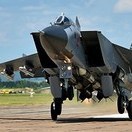-
Posts
144 -
Joined
-
Last visited
OlWilly's Achievements
-
So you're saying that as soon as you established free access, people immediately started getting their way to download more stuff... in amounts unacceptable for your hosting capabilities. Also "bandwidth monthly aggregate average is 2.3 to 2.4 TB, peaks are 5TB and higher", really? This means that a lot of people are still interested in the game which is actually surprising. Does ThirdWire knows about this? The writing on the wall is that they really should make SF3, all of this shows that it will sell well
-
I dug a lot into weapon and avionics parameters and basegame indeed has this issue - I won't say it is biased, more like casualised Default AIM-9M from Israel DLC could easily lock at 20km and then hit without losing much energy. This is ace combat level of "simulation" The energy performance of missiles is likewise all over the place edging on UFO territory I would stress that this is not the engine issue - the engine could model missile performance surprisingly well, I had good results tuning the missiles Unfortunately, without massive rebalancing this is not easily solvable
-
Since the engine is 32bit it remains bottlenecked by RAM. It works alright with vanilla assets and you can max the setting as much as you want. The more new stuff you add to the mission, the worse it gets. You can take a default map and spam it with F-100s for example, even with dozens of them flying around it will work alright. But once you start adding new high def stuff, the performance drops - you can test it with high def ground vehicle pack or certain aircraft. The more different stuff you add, the worse it gets Old MSFS titles have polygon limiter to prevent modders from overloading the game engine - but here you can take a high def model ripped straight from DCS and the engine will still try to process it
- 13 replies
-
- 1
-

-
- settings
- optimization
- (and 15 more)
-

MiG-21 modeling discussion.
OlWilly replied to yakarov79's topic in Thirdwire: Strike Fighters 2 Series - General Discussion
Since autopilot on MiG-21 was still fairly basic, this indicator was used to give pilot visual cues on required intercept course. Works similar to glideslope/course director on landing, you align the movable lines with the cross in the center and it means you go right. On later models like MiG-23 and MiG-25 this was directly linked with autopilot so it could take commands directly from CGI without pilot supervision. Pilot could almost take a nap but he still retained throttle control The vertical aka azimuth line could be made to work within base SF2 avionics - the game supports course indicators. Horizontal aka altitude line unfortunately won't work outside of landing waypoints -
No mention of required subscription on the download page. No mention of it on the frontpage. I assume nothing is said about it when registering as well. What's the reason for not putting a banner with big block letters on download or front page saying "Downloads are available only for subscribers?" That other site, a-team or whatever, has the paywall mentioned right on the frontpage in big red letters, you won't miss that Unless you are trying being low-key about it I see no reasons not doing that
-
Ghostofkyiv started following OlWilly
-
SymbolType=TD_RADAR is for target locked in STT SymbolType=TD_HEAT is for target locked by SRM own seeker Usually it's two different symbols so they don't overlap. Also remember that most fighters could slave SRM seeker to a radar I am not sure if you can disable TD_RADAR when SRM is selected since it's two different functions
-

Aircraft ruggedness
OlWilly replied to OlWilly's topic in Thirdwire: Strike Fighters 2 Series - Mods & Skinning Discussion
I've definitely seen that in some of planes I adjusted. Your method is superior, as it allows for finer tuning and better results, but requires matching the armor values for nearly every aircraft individually. You can do things like, for example, having a multi engine bomber and giving its engines better protection from the rear and sides, but worse from the front, encouraging frontal attacks. StructrualFactor is just simpler, you can slap it on every component and get the durability boost -
If you compare SF with other sims you may notice that planes explode way too easily. You just look at the plane funny and it's already going down in a ball of flames. In my install I went out to fix this. Generally, every airplane part (fuselage, inner wing, etc) has its own HP bar. Once it's depleted, it's gone. HP pool is determined by the size of the part - obviously, B-52's inner wing would have more HP than F-15's. StructuralFactor statement is a plain multiplier for every such part. At 1.0 it does nothing, leaving HP at 100%, at 2.0 it makes it 200%, etc. So, what I did, I gave every structural part a StructuralFactor=2.0, unless it was already higher. This gave some ruggedness, but planes were still exploding too much. The issue is fuel tanks. They are big, always get hit, and once hit - leakage, fire or explosion proc very easily. This allows stuff like easy kills with just 1-2 cannon hits. I wasn't looking for an elegant solution, and as a dirty crutch just added 35mm of steel armor on every fuel tank (it has no weight so alright). This is not supposed to represent any real-world protection, just to crutch over game's engine mechanics. And it gave good results. Aircraft did not become indestructible, a good missile hit or aimed burst still takes it down. But aircraft (you and AI alike) now can take some non-critical damage, and you may even see damaged planes actually hit the ground. For the first time while playing, I managed to get hit and lose one engine, limping home instead of outright exploding. Another issue is ground vehicles. In vanilla SF, a single 20mm shell destroys any tank from a single hit, from any projection, which is wrong. After experimenting I found that ground vehicles have pitiful HP bars and you need to up them literally by 1000s. For example, I gave T-55 StructuralFactor=4000.0 for hull StructuralFactor=5000.0 for a turret. You would think that this is a lot, but a single Maverick still gets it; if you use cannon, now you have to work for a kill. The downside of this is that you have to apply changes manually to every vehicle you want to have it. I had a lot of available time during night shifts, but it is really a tedious process. But it makes dogfights and ground attacks more involved for sure
-

Su-17 Fitter-C V1.0
OlWilly replied to FLOGGER23's topic in Thirdwire: Strike Fighters 2 Series - File Announcements
I see a number of typos in cockpit labels on the screenshot. Usually I would offer to help spellchecking them, but no point in it now -

Strike Fighters Update
OlWilly replied to PJB's topic in Thirdwire: Strike Fighters 2 Series - General Discussion
The decision to drop Strike Fighters series is actually strange from financial point of view. For post WWII era we have two great study sims - DCS and Falcon BMS. Lots of arcade flight games (not worthy being called sims), like Ace Combat or whatever. But for survey, lighter sims, right in the middle, there is an actual shortage on the market. Notice how Nuclear Option waltzed in and seized a decent following just overnight, and it is still in Early Access. A lot of people enjoy sim mode in War Thunder, but hate the grind, and won't mind an offline or less grindy version/spin-off of it. Strike Fighters 3 would easily get its share of the market, especially if it will have an online mode, but without the grind like in WT- 35 replies
-
- 3
-

-
- thirdwire
- strikefighters
- (and 5 more)
-
From my understanding, BoresightElevation and BoresightAzimuth define the direction of the beam. In this case, it will be 0 azimuth - straight center, and -2 elevation, meaning that it's angled down -2 degrees from the aircraft's centerline. BoresightBeamAngle should be the width of the cone, imagine it not as a "line" but as a "cone" with apex being placed at emitter and degree being measured from the centerline (or bore in that matter)
-
.LOD in general is not owned by TW, but this is the "umbrella" format of sorts. Some other games used .LOD too, and guess what, they are incompatible with SF2 Generally, I don't recommend this format for open source game as it is a locked format, with no easy editing. Strike Fighters .LOD models are exclusive for Strike Fighters From what I understand, TW is very touchy on the matter of using their 3D assets, so this is a hard no. This is one of the reasons why they choose .LOD format, so no one could touch their precious 3D models On the other hand, modders created tons of decent and great 3D assets for the game, but here comes the issue. All the mods available here are in .LOD too So, you would need their permission and original 3DSMax/Blender/whatever models which would be hard to get. Many modders are no longer active and many original models are lost to time TLDR - if you manage to contact the modders and convince them to share their original 3DSMax/Blender/whatever models, you are good to go. But if you want to work with SF .LOD format, you're out of luck


